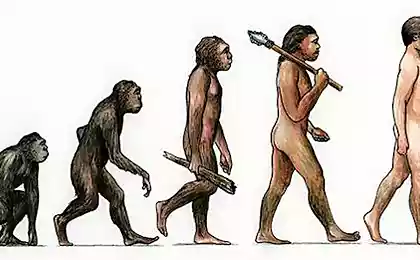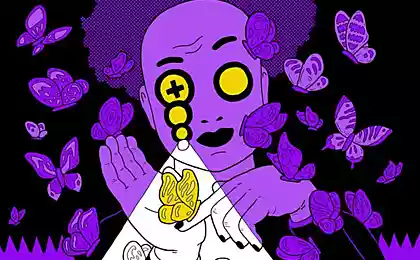431
Spiral Dynamics: The Evolution of Values by Claire Graves
Today I propose to get acquainted with a very interesting theory of spiral dynamics, built on the research of the American psychologist Claire Graves.

The main ideas of the theory of spiral dynamicsThe development of each individual and of all mankind follows a spiral trajectory, passing through a successive series of levels.
The six levels of the first order are “survival,” “mysticism,” “order,” “serving a higher purpose,” “materialism,” and “the pursuit of the common good.”
At the levels of the second order, there is the disclosure of personal potential and the unity of people with each other.
Levels, each of which corresponds to its sociocultural “meme” and conditional color, are characterized not by types of people, but by ways of thinking.
Harmonious development involves a progressive movement upwards in a spiral; the levels partially overlap.
Each level goes through the stages of “generation”, “climax” and “extinction”.
People and groups can be affected only by forces that correspond to the current circumstances of their lives and the level of their development.
The spiral modelThe theory of spiral dynamics describes eight interrelated levels of maturity of the individual and society. Each level corresponds to a certain set of cultural values, its color, its priorities, beliefs and worldview. As people and peoples develop, they move from level to level under the influence of living conditions and experience in problem solving. When the conditions of an individual, organization, or society change, this transformation forces the revision of basic values and beliefs. Problems that cannot be solved within the framework of the existing value system force us to rise to the next spiral. The levels overlap in part, passing through the phases of “birth”, “climax” and “extinction”. This evolution takes place over a long period of time: a person or society leaves the previous level and slowly moves to the next level that appears on the horizon. Problems arise when something interferes with such progress.

The spiral model is a tool for managing the transformation process. But to use it, first of all, it is necessary to understand at what level of development a person or a team is, and then you can choose the methods of implementing changes accordingly. These levels do not characterize the type of personality, but the way of thinking.
As a rule, we are influenced by several layers of values, or ideological complexes, called “memes”. Any major transformation must take into account the peculiarities of the level at which the person or society is located. Thus, attempts to quickly create a free market economy in a country that has been under authoritarian rule for decades are doomed to failure. Such a country must undergo a stage of gradual liberalization and respect for individual freedom, so that the desire for independence and the spirit of entrepreneurship develop in society.
Learning how to define an individual or group is not easy, nor is it easy to cope with the desire to accelerate change. The spiral dynamics model has enormous potential to drive change in a variety of contexts, including organizations. Its scope of application is almost limitless.Colors: Levels and Value Systems
Levels of development, each of which corresponds to a certain value meme, reflect the psychocultural maturity of the individual or society. The first six levels (first-order levels) correspond to the following colors:
Beige
This is the Stone Age, in which people are ruled by instincts, and their main concern is survival. They gather in groups not to communicate, but to co-produce food and protect against threats.
Children quickly leave this spiral, like most primitive cultures. Older people can drop to the “beige” level if they suffer from Alzheimer’s disease. With collectives that are at the “beige” level, it is necessary to work, appealing to the senses (vision, taste, touch). At this level of development is less than 0.1% of the world’s population, in the hands of which only 0.01% of political power.
Purple.
Driven by the desire to improve their living conditions, people enter into more complex social associations, moving from families and clans to tribes. Tribal life is governed by rituals, mysticism, belief in spirits and ancestor worship. Their members submit to common rituals, observe prohibitions, and respect blood ties. To influence a person or group with this level of consciousness, show members that you respect their customs and customs. For example, the features of the “purple” level can be demonstrated by a sports team. Criticism of the superstitions common in such a group causes a negative reaction in him. About 10% of people still live in clans and tribes, concentrating about 1% of political power in their hands.
Red.
The color purple is replaced by red when people realize the inconsistency of superstitions and the meaninglessness of rituals. When group members challenge the power of the exploiting rulers, the latter become even more oppressive, which accelerates change. As soon as the agreement between the members of the group disappears, anarchy arises, after which power is in the hands of dictators. In a cruel red world, the law of the jungle reigns, tyrants rule empires, and power is supreme.
Everyone wants to take their share of the good and believe that the strongest will survive. In society there is a rigid hierarchy, authoritarianism, rigidity of thinking, cruelty. People have no sympathy for each other. To achieve change at the red level, teach people to respect others and protect their reputation. Any attempts to bring the collective closer together will be met with hostility by its members. Explain in red what their “benefit” is: instead of anarchy, offer them order and service to a higher purpose. At this level there are about 20% of people, who account for about 5% of political power.
blue
The desire for order heralds an approach to the “blue” level, which is characterized by predictability, patriotism and self-sacrifice for a higher goal. In the “blue” world, tight control and authoritarianism still reign, but leaders are distinguished by a “fatherly” attitude towards the people, not a desire for self-aggrandizement. To transform this society, teach people to value personal merit and receive rewards for success. Respect their traditions. Do not encourage wasteful, ostentatious consumption and social dependency. The blue level is the largest segment of the world’s population, with 40% of people concentrating 30% of political power.
Orange
This level is replaced by “blue” when people question the authority of the authorities. If leaders abuse their position, it accelerates change. As soon as people realize that they know how to live better than the authorities, they cease to be loyal. They begin to think more freely, and the beginnings of entrepreneurship and careerism appear in society. Wanting more, people see the way to a better life in science and technology. Neglect of personal interests for the sake of a higher goal gives way to the pursuit of material goods. The society is dominated by “meritocracy”, the power of the worthy. To influence the Orange team, focus on professionalism, the needs of the team, and the benefits of living in the community. At 30% of the population, this group holds 50% of political power.
Green.
The “orange” level is replaced by the “green” level, when people begin to strive for mutual understanding and development of spirituality. Material goods and personal achievements no longer bring them joy, and the lack of relationships makes them feel lonely. The spirit of competition weakens, and collective well-being and concern for the world around us come to the fore. Decisions are not made by a minority, but by consensus. People begin to be guided by the principle of rational necessity, not greed, they strive for a simple, unburdened by rampant consumption of life. To help them move to the next level, let them know that the “whole-world” movement is ineffective and restrictive. Advise you to take all the good things from other levels. This segment covers 10% of the population and accounts for 15% of political power.
Colors in spiral dynamics
The two levels of the second order correspond to the following two colors:
yellow
Moving to second-order levels is a much more important step than moving between first-order levels. Thoughts and actions here acquire special flexibility and multidimensionality. People and communities find themselves at this level when they become disillusioned with collectivism and become aware of its limitations, but still feel the need to devote themselves to the common good.
There is a resurgence of repressed individualism, however, devoid of the desire for luxury and high status characteristic of the “orange” level. Those at this level skillfully combine individuals and groups at different levels of development into a single organism to solve a specific problem. They do not need to be recognized for their merits. These people have outgrown the desire to compete and assert themselves and in search of their “I” try not to harm others. The yellow level begins to recede as soon as people realize the limitations of the individual and unite to solve the global problems of human existence. The 1% of the population that reaches this level controls about 5% of political power.
turquoise
As people, having studied the possibilities and limitations of individualism well, return to balanced collectivism, they again begin to show the self-sacrifice lost after leaving the blue level. If the “yellow” level is the creation and solution of problems, then the “turquoise” level is the unification of humanity into a single spiritual whole with an orientation towards such priorities as care for the world around, simplicity of life and respect for people at any level. Those at this level aspire to become part of a single network of relationships that all forms of life form. They are able to combine the strengths of all other levels without compromising their self. In the hands of 0.1% of representatives of this level, 1% of political power is concentrated.
Six conditions for changeIn order for people and groups to go through the described process of development, certain conditions must be met. The scale of change and its sustainability depend on this.
Capacity assessment. Is the person, organization or culture sensitive to the changes you intend to make? Are they “open” (you can act), “chained” (remove all barriers first and don’t expect quick success) or “closed” (it’s useless to even try to change something)?
Finding solutions. Find solutions to the problems that exist at this level before incentivizing upward spiraling. Beginning changes, first make sure that a solid foundation is prepared for them.
Creating dissonance. Give evidence that the traditional way of thinking does not meet the new requirements and conditions of life. Describe the dangers that will inevitably result. Take people out of their complacency to make them want to change.
Breaking down barriers. People and communities seek to erect barriers around them that protect against change. Identify these barriers and break them down.
Awakening understanding. Explain why a person or organization needs to change. Indicate what needs to be fixed and help people imagine how it will change their lives for the better.
Consolidation. Transformation is a long process in which breakthroughs alternate with retreats. It must be constantly maintained. If transformation takes place in the organization, its leader should be at the center of the process of change, providing all kinds of support to subordinates.
If these conditions are met, the transformation process will take place in five stages:
1. Alpha Stability.It's okay, people are happy, the system is working.
2. "Beta conditioning." Small problems turn into large, traditional solutions in the new environment do not work. Doubts about the effectiveness of the system are growing. Attempts to remedy the situation by making better use of old working methods only exacerbate the problems.
3. Gamma trap.The problems are becoming increasingly obvious. Denying them is not the best way out. You think it’s better to wait and see how things unfold before you act. But we need to act now. If you delay, you may find yourself in a trap, leading to personal, organizational, and societal collapse. Recovery from such a collapse would be long, if at all possible.
4. Delta burst.Avoiding the “gamma trap” will make you feel euphoric. But there are other pitfalls waiting for you. Changes can make things even worse or turn superficial, and you start slipping back into a trap.
5. " New alpha stability”.If the transformation has been successful and you have escaped the gamma trap, you are at a new stage of development. Keep the system running smoothly before the cycle starts again.
Use an accurate assessment of the five conditions for successful change and monitoring the five stages of the process as tools to help people and communities achieve sustainable change. Act on all levels at once, take into account the benefits that each level provides, and develop solutions suitable for each level. Follow the principles of “politeness” (respect others), “openness” (listen to others), and “autocracy” (manage with a firm hand and take responsibility for yourself).
Before embarking on the path of transformation, figure out what level you are now and what you want to be.. Audit available resources and tools to implement changes. Formulate your vision for the future and share it with your group members. Develop a work plan that covers all actions that affect the process of change. Form a management team that will support the program throughout its execution. Control the process and coordinate the work of the people making the change. Keep moving forward, looking for optimal solutions to problems as they arise.
Author: Roman Kalugin
P.S. And remember, just by changing your consciousness – together we change the world!
Source: //romankalugin.com/teoriya-spiralnoj-dinamki-razvitiya-lichnosti-i-chelovechestva-ot-klera-grejvza/

The main ideas of the theory of spiral dynamicsThe development of each individual and of all mankind follows a spiral trajectory, passing through a successive series of levels.
The six levels of the first order are “survival,” “mysticism,” “order,” “serving a higher purpose,” “materialism,” and “the pursuit of the common good.”
At the levels of the second order, there is the disclosure of personal potential and the unity of people with each other.
Levels, each of which corresponds to its sociocultural “meme” and conditional color, are characterized not by types of people, but by ways of thinking.
Harmonious development involves a progressive movement upwards in a spiral; the levels partially overlap.
Each level goes through the stages of “generation”, “climax” and “extinction”.
People and groups can be affected only by forces that correspond to the current circumstances of their lives and the level of their development.
The spiral modelThe theory of spiral dynamics describes eight interrelated levels of maturity of the individual and society. Each level corresponds to a certain set of cultural values, its color, its priorities, beliefs and worldview. As people and peoples develop, they move from level to level under the influence of living conditions and experience in problem solving. When the conditions of an individual, organization, or society change, this transformation forces the revision of basic values and beliefs. Problems that cannot be solved within the framework of the existing value system force us to rise to the next spiral. The levels overlap in part, passing through the phases of “birth”, “climax” and “extinction”. This evolution takes place over a long period of time: a person or society leaves the previous level and slowly moves to the next level that appears on the horizon. Problems arise when something interferes with such progress.

The spiral model is a tool for managing the transformation process. But to use it, first of all, it is necessary to understand at what level of development a person or a team is, and then you can choose the methods of implementing changes accordingly. These levels do not characterize the type of personality, but the way of thinking.
As a rule, we are influenced by several layers of values, or ideological complexes, called “memes”. Any major transformation must take into account the peculiarities of the level at which the person or society is located. Thus, attempts to quickly create a free market economy in a country that has been under authoritarian rule for decades are doomed to failure. Such a country must undergo a stage of gradual liberalization and respect for individual freedom, so that the desire for independence and the spirit of entrepreneurship develop in society.
Learning how to define an individual or group is not easy, nor is it easy to cope with the desire to accelerate change. The spiral dynamics model has enormous potential to drive change in a variety of contexts, including organizations. Its scope of application is almost limitless.Colors: Levels and Value Systems
Levels of development, each of which corresponds to a certain value meme, reflect the psychocultural maturity of the individual or society. The first six levels (first-order levels) correspond to the following colors:
Beige
This is the Stone Age, in which people are ruled by instincts, and their main concern is survival. They gather in groups not to communicate, but to co-produce food and protect against threats.
Children quickly leave this spiral, like most primitive cultures. Older people can drop to the “beige” level if they suffer from Alzheimer’s disease. With collectives that are at the “beige” level, it is necessary to work, appealing to the senses (vision, taste, touch). At this level of development is less than 0.1% of the world’s population, in the hands of which only 0.01% of political power.
Purple.
Driven by the desire to improve their living conditions, people enter into more complex social associations, moving from families and clans to tribes. Tribal life is governed by rituals, mysticism, belief in spirits and ancestor worship. Their members submit to common rituals, observe prohibitions, and respect blood ties. To influence a person or group with this level of consciousness, show members that you respect their customs and customs. For example, the features of the “purple” level can be demonstrated by a sports team. Criticism of the superstitions common in such a group causes a negative reaction in him. About 10% of people still live in clans and tribes, concentrating about 1% of political power in their hands.
Red.
The color purple is replaced by red when people realize the inconsistency of superstitions and the meaninglessness of rituals. When group members challenge the power of the exploiting rulers, the latter become even more oppressive, which accelerates change. As soon as the agreement between the members of the group disappears, anarchy arises, after which power is in the hands of dictators. In a cruel red world, the law of the jungle reigns, tyrants rule empires, and power is supreme.
Everyone wants to take their share of the good and believe that the strongest will survive. In society there is a rigid hierarchy, authoritarianism, rigidity of thinking, cruelty. People have no sympathy for each other. To achieve change at the red level, teach people to respect others and protect their reputation. Any attempts to bring the collective closer together will be met with hostility by its members. Explain in red what their “benefit” is: instead of anarchy, offer them order and service to a higher purpose. At this level there are about 20% of people, who account for about 5% of political power.
blue
The desire for order heralds an approach to the “blue” level, which is characterized by predictability, patriotism and self-sacrifice for a higher goal. In the “blue” world, tight control and authoritarianism still reign, but leaders are distinguished by a “fatherly” attitude towards the people, not a desire for self-aggrandizement. To transform this society, teach people to value personal merit and receive rewards for success. Respect their traditions. Do not encourage wasteful, ostentatious consumption and social dependency. The blue level is the largest segment of the world’s population, with 40% of people concentrating 30% of political power.
Orange
This level is replaced by “blue” when people question the authority of the authorities. If leaders abuse their position, it accelerates change. As soon as people realize that they know how to live better than the authorities, they cease to be loyal. They begin to think more freely, and the beginnings of entrepreneurship and careerism appear in society. Wanting more, people see the way to a better life in science and technology. Neglect of personal interests for the sake of a higher goal gives way to the pursuit of material goods. The society is dominated by “meritocracy”, the power of the worthy. To influence the Orange team, focus on professionalism, the needs of the team, and the benefits of living in the community. At 30% of the population, this group holds 50% of political power.
Green.
The “orange” level is replaced by the “green” level, when people begin to strive for mutual understanding and development of spirituality. Material goods and personal achievements no longer bring them joy, and the lack of relationships makes them feel lonely. The spirit of competition weakens, and collective well-being and concern for the world around us come to the fore. Decisions are not made by a minority, but by consensus. People begin to be guided by the principle of rational necessity, not greed, they strive for a simple, unburdened by rampant consumption of life. To help them move to the next level, let them know that the “whole-world” movement is ineffective and restrictive. Advise you to take all the good things from other levels. This segment covers 10% of the population and accounts for 15% of political power.
Colors in spiral dynamics
The two levels of the second order correspond to the following two colors:
yellow
Moving to second-order levels is a much more important step than moving between first-order levels. Thoughts and actions here acquire special flexibility and multidimensionality. People and communities find themselves at this level when they become disillusioned with collectivism and become aware of its limitations, but still feel the need to devote themselves to the common good.
There is a resurgence of repressed individualism, however, devoid of the desire for luxury and high status characteristic of the “orange” level. Those at this level skillfully combine individuals and groups at different levels of development into a single organism to solve a specific problem. They do not need to be recognized for their merits. These people have outgrown the desire to compete and assert themselves and in search of their “I” try not to harm others. The yellow level begins to recede as soon as people realize the limitations of the individual and unite to solve the global problems of human existence. The 1% of the population that reaches this level controls about 5% of political power.
turquoise
As people, having studied the possibilities and limitations of individualism well, return to balanced collectivism, they again begin to show the self-sacrifice lost after leaving the blue level. If the “yellow” level is the creation and solution of problems, then the “turquoise” level is the unification of humanity into a single spiritual whole with an orientation towards such priorities as care for the world around, simplicity of life and respect for people at any level. Those at this level aspire to become part of a single network of relationships that all forms of life form. They are able to combine the strengths of all other levels without compromising their self. In the hands of 0.1% of representatives of this level, 1% of political power is concentrated.
Six conditions for changeIn order for people and groups to go through the described process of development, certain conditions must be met. The scale of change and its sustainability depend on this.
Capacity assessment. Is the person, organization or culture sensitive to the changes you intend to make? Are they “open” (you can act), “chained” (remove all barriers first and don’t expect quick success) or “closed” (it’s useless to even try to change something)?
Finding solutions. Find solutions to the problems that exist at this level before incentivizing upward spiraling. Beginning changes, first make sure that a solid foundation is prepared for them.
Creating dissonance. Give evidence that the traditional way of thinking does not meet the new requirements and conditions of life. Describe the dangers that will inevitably result. Take people out of their complacency to make them want to change.
Breaking down barriers. People and communities seek to erect barriers around them that protect against change. Identify these barriers and break them down.
Awakening understanding. Explain why a person or organization needs to change. Indicate what needs to be fixed and help people imagine how it will change their lives for the better.
Consolidation. Transformation is a long process in which breakthroughs alternate with retreats. It must be constantly maintained. If transformation takes place in the organization, its leader should be at the center of the process of change, providing all kinds of support to subordinates.
If these conditions are met, the transformation process will take place in five stages:
1. Alpha Stability.It's okay, people are happy, the system is working.
2. "Beta conditioning." Small problems turn into large, traditional solutions in the new environment do not work. Doubts about the effectiveness of the system are growing. Attempts to remedy the situation by making better use of old working methods only exacerbate the problems.
3. Gamma trap.The problems are becoming increasingly obvious. Denying them is not the best way out. You think it’s better to wait and see how things unfold before you act. But we need to act now. If you delay, you may find yourself in a trap, leading to personal, organizational, and societal collapse. Recovery from such a collapse would be long, if at all possible.
4. Delta burst.Avoiding the “gamma trap” will make you feel euphoric. But there are other pitfalls waiting for you. Changes can make things even worse or turn superficial, and you start slipping back into a trap.
5. " New alpha stability”.If the transformation has been successful and you have escaped the gamma trap, you are at a new stage of development. Keep the system running smoothly before the cycle starts again.
Use an accurate assessment of the five conditions for successful change and monitoring the five stages of the process as tools to help people and communities achieve sustainable change. Act on all levels at once, take into account the benefits that each level provides, and develop solutions suitable for each level. Follow the principles of “politeness” (respect others), “openness” (listen to others), and “autocracy” (manage with a firm hand and take responsibility for yourself).
Before embarking on the path of transformation, figure out what level you are now and what you want to be.. Audit available resources and tools to implement changes. Formulate your vision for the future and share it with your group members. Develop a work plan that covers all actions that affect the process of change. Form a management team that will support the program throughout its execution. Control the process and coordinate the work of the people making the change. Keep moving forward, looking for optimal solutions to problems as they arise.
Author: Roman Kalugin
P.S. And remember, just by changing your consciousness – together we change the world!
Source: //romankalugin.com/teoriya-spiralnoj-dinamki-razvitiya-lichnosti-i-chelovechestva-ot-klera-grejvza/























